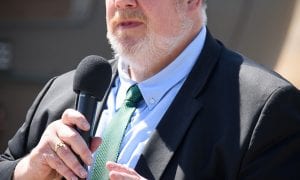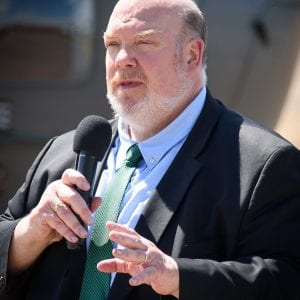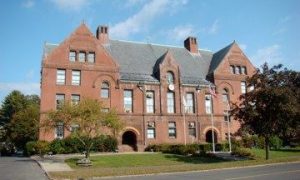
Westfield City Councilor Richard E. Onofrey Jr., questions Westfield Assesser James M. Pettengill during Thursday night’s City Council meeting. (Photo by chief photographer Frederick Gore)
WESTFIELD – The City Council conducted a public hearing Thursday night on the proposed tax levy which will eventually be used to set the tax rate for various classes of property.
Assessor James Pettengill presented the council members with property tax shift options that could slide the percentage borne by each class of real and personal property.
Pettengill said that the total value of property in Westfield is $3,182,645,428 and that the total value of residential property comprises 82.85 percent of that with $2,637,099,207.
The remaining 17.14 percent of the $3 billion is divided among industrial property ($137,515,200 of 4.3 percent), commercial property ($337,822,066 or 10.6 percent) and personal property ($70,208,955 or 2.2 percent).
The city also had $830,603 in new growth, a number that is also included in the formula that will determine the tax rate.
The City Council, which referred Pettengill’s report to its Finance Committee for further review, will vote on the “shift” between residential and the other property classes. The shift factor moves the tax burden, typically from residential property to commercial, industrial and personal property.
State law allows communities to adopt either a flat tax rate, under which all property classes are taxed at one rate, of to adopt a shift.
Last year the council adopted a shift of 1.64.
The other decision the City Council has to make is the percentage of increase in the tax rate. State law allows an increase of up to 2 1/2 percent.
The two decisions resulted in a residential tax rate of $15.41 percent $1,000 of property value and a commercial, industrial and personal tax rate of $29.13 per $1,000 of property value.
That tax rate generated $56 million for the current fiscal year budget.
Pettengill said that if council votes the 2 1/2 percent maximum, the tax level this year will be $59,138,974. However a lower increase, such as 2 percent, the number used last year, would result in a total tax levy of $58,854,543.
If the council approved the same 1.64 shift and a 2 1/2 percent increase, the residential tax rate will be $16.12 per $1,000 and the commercial, industrial and personal tax rate will be $30.47 per $1,000.
Bill Parks, president of the Greater Westfield Chamber of Commerce Board of Directors, and Sean Hogan, a business owner and Chamber member, urged the council to adopt a shift of 1.61 which would shift tax burden away from businesses.
At 2 1/2 percent a 1,61 shift would result in a residential rate of $16.24 and a commercial, industrial and personal rate of $29.92.
At-large Council David A. Flaherty and Ward 5 Councilor Richard E. Onfrey Jr., both members of the Finance Committee crunched the numbers and questioned the actual tax increase.
Onofrey said that he calculated residential taxpayers would see a 4 percent increase, while commercial, industrial and personal taxpayers would see a 4 1/2 percent increase.
Flaherty commented that the 1.61 shift actually results in a commercial, industrial and personal property tax that is 180 percent of the residential rate.
Pettengill said, in response to Onofry’s question, that state law allows community to add new growth on top of the tax rate increase and shift approved by the council.
“New growth takes a year to catch up to the levy,” he said.
Council President Christopher Keefe, who is the assessor in West Springfield, said the property value in Westfield has shown “surprising strength” in the current economy.
“The values on the commercial, industrial and personal property have gone up,” Keefe said. “This is a political decision that this body must make in determining how we allocate the tax burden.”





